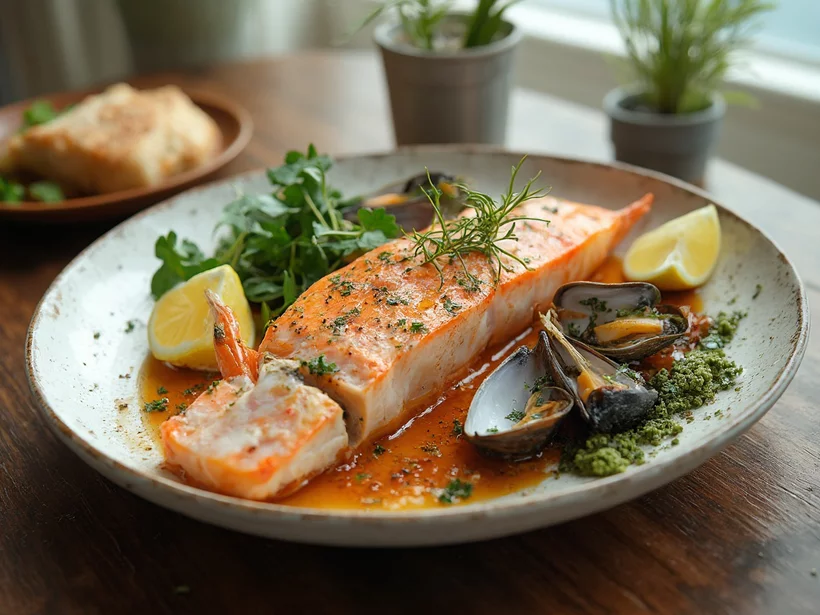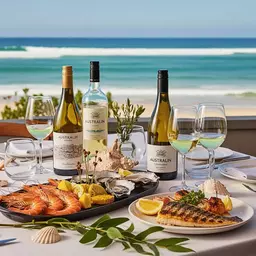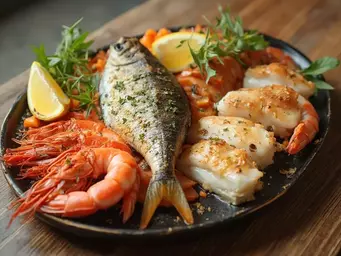Choosing Sustainable Seafood in Australia

As we navigate the waters of modern dining, the choices we make about seafood can create ripples of impact on our oceans. Advocating for sustainable seafood isn't just a trend; it's a commitment to preserving the rich marine ecosystems that provide us with nourishment and joy. Are you ready to dive into this crucial topic and discover how your choices can shape a brighter future for our oceans?
What You Will Learn
- Sustainable seafood is defined by fishing and farming practices that prioritize marine health and ecosystem balance.
- Responsible fishing methods minimize environmental impact and support the recovery of overfished species.
- Choosing seasonal seafood helps reduce pressure on overfished populations, making a significant difference.
- Look for sustainability certifications like MSC or ASC to ensure your seafood choices align with conservation efforts.
- Interactive tools, such as Seafood Watch, can guide consumers in making informed seafood purchases.
- Enjoying sustainable seafood not only benefits the environment but also offers nutritional advantages, such as omega-3 fatty acids.
Sustainable Seafood Practices and Consumer Actions
This visual outlines key aspects of sustainable seafood, focusing on the meaning, importance, and actionable steps consumers can take to support healthier marine ecosystems.
What Does Sustainable Seafood Mean?
- Responsible fishing methods: Minimize environmental impact & bycatch.
- Farmed seafood: Avoid pollution & habitat destruction.
- Conservation efforts: Support recovery of overfished populations.
Interactive Tools for Sustainable Seafood Decisions
- Seafood Watch: App for sustainability ratings.
- GoodFish: Online platform for local sustainable options.
- FishChoice: Industry resource with extensive sustainability ratings.
Understanding Sustainable Seafood in Australia
As a passionate food enthusiast, I often find myself pondering the intricate tapestry of our culinary practices here in Australia, particularly when it comes to seafood. Sustainable seafood is more than just a buzzword; it embodies a commitment to our oceans and the delicate ecosystems that sustain them. So, what does sustainable seafood truly mean?
To put it simply, sustainable seafood refers to fish and shellfish that are caught or farmed in ways that prioritize the health of marine species and their habitats. This concept not only advocates for responsible harvesting methods but also ensures that the seafood we enjoy today does not compromise the ability of future generations to savor these treasures of the sea. Have you ever thought about the journey your fish takes before it reaches your plate?
What Does Sustainable Seafood Mean?
Sustainable seafood is rooted in practices that aim to protect our marine ecosystems. This includes:
- Responsible fishing methods: Techniques that minimize environmental impact and bycatch.
- Farmed seafood: Practices that avoid pollution and habitat destruction.
- Conservation efforts: Initiatives that support the recovery of overfished populations.
By understanding these principles, we can make informed choices that support healthier oceans and more resilient fishing communities. Every meal is an opportunity to directly influence these vital ecosystems!
The Importance of Sustainable Fishing Practices
As I explore various coastal regions in Australia, I’m continually amazed by the rich diversity of our seafood offerings. However, this abundance must be managed carefully. Sustainable fishing practices are crucial for several reasons:
- They help maintain fish populations at healthy levels.
- They protect marine habitats from destruction.
- They support local economies reliant on fishing.
Through sustainable practices, we not only preserve fish stocks but also provide a stable future for those whose livelihoods depend on the sea. This is a collective responsibility we share as consumers and advocates of ethical dining.
Exploring the Role of Australian Fisheries in Sustainability
Australian fisheries have made significant strides towards sustainability, aiming to balance economic viability with ecological health. Many fisheries are committed to strict regulations that limit catch sizes and protect breeding grounds. This ensures the long-term health of our marine resources. You can learn more about these efforts to manage fisheries sustainably by visiting the Australian Department of Agriculture, Fisheries and Forestry's National Fisheries Plan. But how do we know which fisheries to support? By looking for certifications and labels that indicate adherence to sustainable practices!
As part of my journey at The Yellow Tail Table, I’ve had the opportunity to visit various fisheries that prioritize sustainable practices. Here, local fishers work diligently to utilize methods that protect marine life while still providing delicious seafood. This connection between the source and the table is a story worth sharing! So next time you're enjoying a meal featuring fish, consider the journey it took to get there and the sustainable practices that made it possible. For additional insights into Australian marine conservation, explore resources from the Australian Marine Conservation Society.
Pro Tip
When purchasing seafood, always ask your fishmonger about the sourcing and sustainability of the products. This not only supports responsible fisheries but also educates you on the journey of your seafood, enhancing your culinary experience!
Encouraging Sustainable Seafood Choices
As consumers, we hold the power to influence the seafood industry towards more sustainable practices. Every choice we make—whether it's opting for a particular fish or supporting a local vendor—can have a significant impact on our oceans and the community. At The Yellow Tail Table, we believe that making informed decisions about our seafood consumption is not only beneficial for the environment but also enriches our culinary experiences!
How You Can Make a Difference as a Consumer
Embracing sustainable seafood starts with understanding your options. Here are some actionable steps you can take to support sustainability:
- Choose seafood that is in season to reduce the pressure on overfished species.
- Look for sustainability certifications when buying seafood, such as those from the Marine Stewardship Council (MSC) or Aquaculture Stewardship Council (ASC).
- Ask your local fishmonger about the sourcing of their seafood.
- Participate in community-supported fisheries (CSFs) to directly support local fishermen.
- Educate friends and family about the importance of sustainable seafood.
These small changes in our purchasing habits can collectively lead to a healthier ocean and a more robust seafood supply chain!
Interactive Tools and Resources for Sustainable Seafood Decisions
Luckily, there are many tools available to help you make informed seafood choices. Here are some resources that we recommend:
- Seafood Watch: An app that provides recommendations based on sustainability ratings.
- GoodFish: An online platform that lists sustainable seafood options available in your area.
- FishChoice: An industry resource that provides an extensive seafood database with sustainability ratings.
Using these tools can empower you to select seafood that aligns with your values and promotes a more sustainable future!
Understanding Seafood Nutrition and Cooking with Sustainable Options
Sustainable seafood not only benefits the environment but also offers a wealth of nutritional benefits. Eating fish contributes essential nutrients such as omega-3 fatty acids, which are vital for heart health. Here are some nutritious sustainable seafood options you might want to consider:
- Barramundi: Rich in omega-3s and known for its delectable taste, this fish is a sustainable choice.
- Pacific Sardines: They are nutrient-dense and abundant, making them an excellent eco-friendly option.
- Flathead: Delicious and versatile, flathead is a fantastic choice for various dishes.
Incorporating these options into your meals not only enhances your diet but also supports sustainable fishing practices. So, the next time you're planning a dinner, why not try a sustainable seafood recipe? It can be both delicious and eco-conscious!
Frequently Asked Questions (FAQs) about Sustainable Seafood
- What is sustainable seafood?
- Sustainable seafood refers to fish and shellfish that are caught or farmed in ways that minimize environmental impact, maintain healthy marine populations, and protect aquatic habitats for future generations.
- Why are sustainable fishing practices important?
- Sustainable fishing practices are crucial because they help maintain fish populations at healthy levels, protect marine habitats from destruction, minimize bycatch of non-target species, and support the long-term economic viability of fishing communities.
- How can consumers identify sustainable seafood?
- Consumers can identify sustainable seafood by looking for certifications from reputable organizations like the Marine Stewardship Council (MSC) or Aquaculture Stewardship Council (ASC. They can also use interactive tools like Seafood Watch or GoodFish, and ask their fishmongers about the sourcing of their products.
- What are some examples of sustainable seafood options?
- Some examples of sustainable seafood options mentioned in the article include Barramundi, Pacific Sardines, and Flathead. The best choices often depend on local availability and season.
- How do Australian fisheries contribute to sustainability?
- Australian fisheries are making significant strides toward sustainability through strict regulations, limiting catch sizes, protecting breeding grounds, and adhering to international best practices to ensure the long-term health of marine resources.
Recap of Key Points
Here is a quick recap of the important points discussed in the article:
- Sustainable seafood refers to fish and shellfish caught or farmed in ways that prioritize the health of marine species and their habitats.
- Key practices include responsible fishing methods, sustainable farming practices, and conservation efforts that support recovering fish populations.
- As consumers, our choices can significantly impact the seafood industry—opting for seasonal seafood and certified sustainable options is crucial.
- Utilize tools like Seafood Watch and GoodFish to help make informed decisions about sustainable seafood options.
- Nutrition benefits of sustainable seafood include essential nutrients like omega-3 fatty acids, enhancing both health and culinary experiences.









